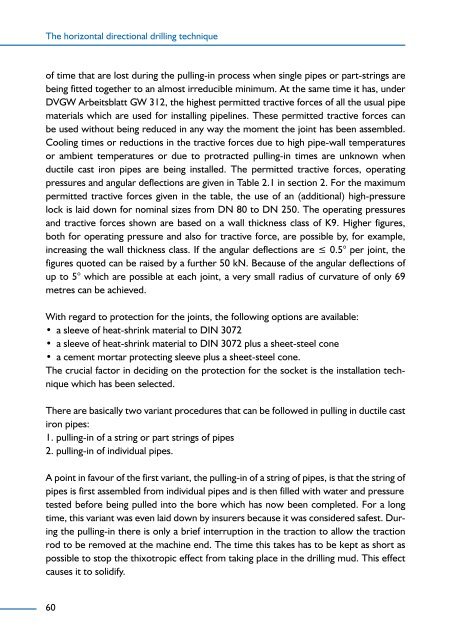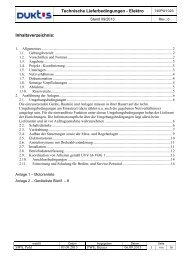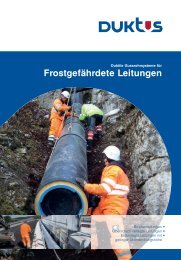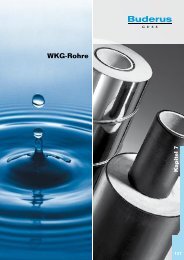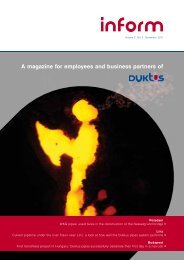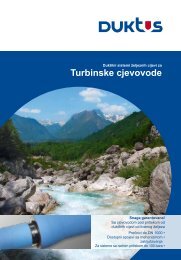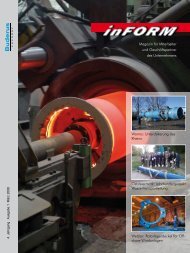Buderus Manual on Trenchless Installation of Ductile Cast ... - Duktus
Buderus Manual on Trenchless Installation of Ductile Cast ... - Duktus
Buderus Manual on Trenchless Installation of Ductile Cast ... - Duktus
You also want an ePaper? Increase the reach of your titles
YUMPU automatically turns print PDFs into web optimized ePapers that Google loves.
The horiz<strong>on</strong>tal directi<strong>on</strong>al drilling technique<br />
<strong>of</strong> time that are lost during the pulling-in process when single pipes or part-strings are<br />
being fitted together to an almost irreducible minimum. At the same time it has, under<br />
DVGW Arbeitsblatt GW 312, the highest permitted tractive forces <strong>of</strong> all the usual pipe<br />
materials which are used for installing pipelines. These permitted tractive forces can<br />
be used without being reduced in any way the moment the joint has been assembled.<br />
Cooling times or reducti<strong>on</strong>s in the tractive forces due to high pipe-wall temperatures<br />
or ambient temperatures or due to protracted pulling-in times are unknown when<br />
ductile cast ir<strong>on</strong> pipes are being installed. The permitted tractive forces, operating<br />
pressures and angular deflecti<strong>on</strong>s are given in Table 2.1 in secti<strong>on</strong> 2. For the maximum<br />
permitted tractive forces given in the table, the use <strong>of</strong> an (additi<strong>on</strong>al) high-pressure<br />
lock is laid down for nominal sizes from DN 80 to DN 2 0. The operating pressures<br />
and tractive forces shown are based <strong>on</strong> a wall thickness class <strong>of</strong> K9. Higher figures,<br />
both for operating pressure and also for tractive force, are possible by, for example,<br />
increasing the wall thickness class. If the angular deflecti<strong>on</strong>s are ≤ 0.5° per joint, the<br />
figures quoted can be raised by a further 0 kN. Because <strong>of</strong> the angular deflecti<strong>on</strong>s <strong>of</strong><br />
up to ° which are possible at each joint, a very small radius <strong>of</strong> curvature <strong>of</strong> <strong>on</strong>ly 9<br />
metres can be achieved.<br />
With regard to protecti<strong>on</strong> for the joints, the following opti<strong>on</strong>s are available:<br />
• a sleeve <strong>of</strong> heat-shrink material to DIN 3072<br />
• a sleeve <strong>of</strong> heat-shrink material to DIN 3072 plus a sheet-steel c<strong>on</strong>e<br />
• a cement mortar protecting sleeve plus a sheet-steel c<strong>on</strong>e.<br />
The crucial factor in deciding <strong>on</strong> the protecti<strong>on</strong> for the socket is the installati<strong>on</strong> technique<br />
which has been selected.<br />
There are basically two variant procedures that can be followed in pulling in ductile cast<br />
ir<strong>on</strong> pipes:<br />
1. pulling-in <strong>of</strong> a string or part strings <strong>of</strong> pipes<br />
2. pulling-in <strong>of</strong> individual pipes.<br />
A point in favour <strong>of</strong> the first variant, the pulling-in <strong>of</strong> a string <strong>of</strong> pipes, is that the string <strong>of</strong><br />
pipes is first assembled from individual pipes and is then filled with water and pressure<br />
tested before being pulled into the bore which has now been completed. For a l<strong>on</strong>g<br />
time, this variant was even laid down by insurers because it was c<strong>on</strong>sidered safest. During<br />
the pulling-in there is <strong>on</strong>ly a brief interrupti<strong>on</strong> in the tracti<strong>on</strong> to allow the tracti<strong>on</strong><br />
rod to be removed at the machine end. The time this takes has to be kept as short as<br />
possible to stop the thixotropic effect from taking place in the drilling mud. This effect<br />
causes it to solidify.<br />
0


